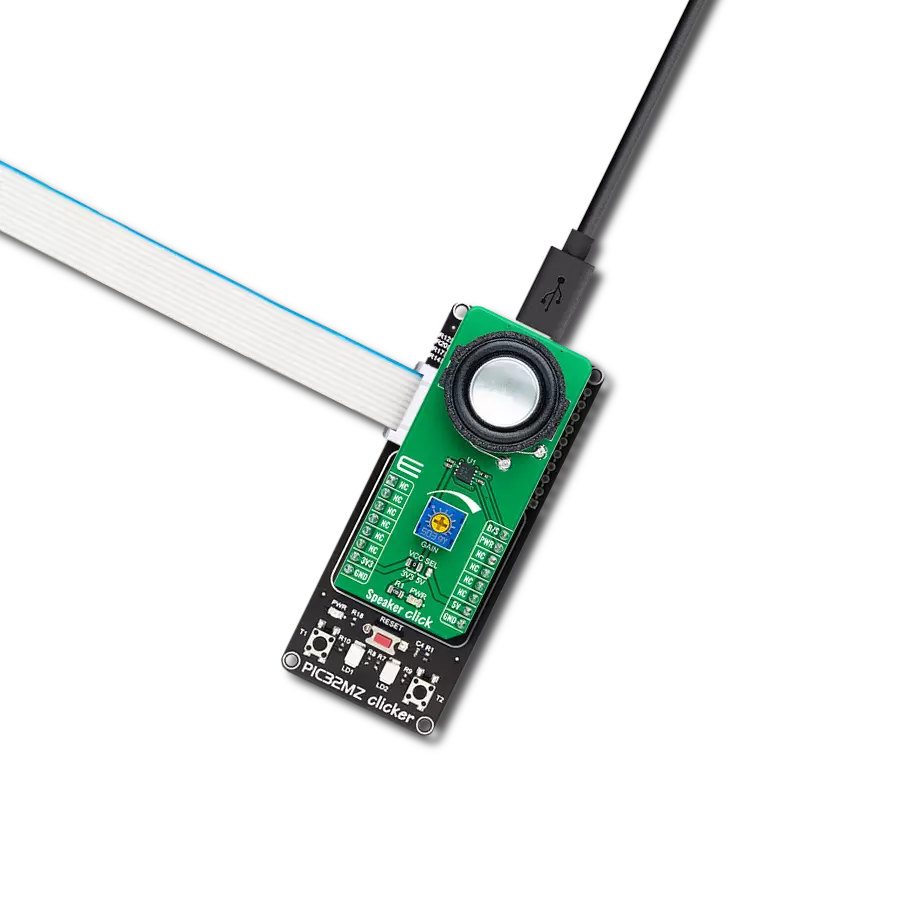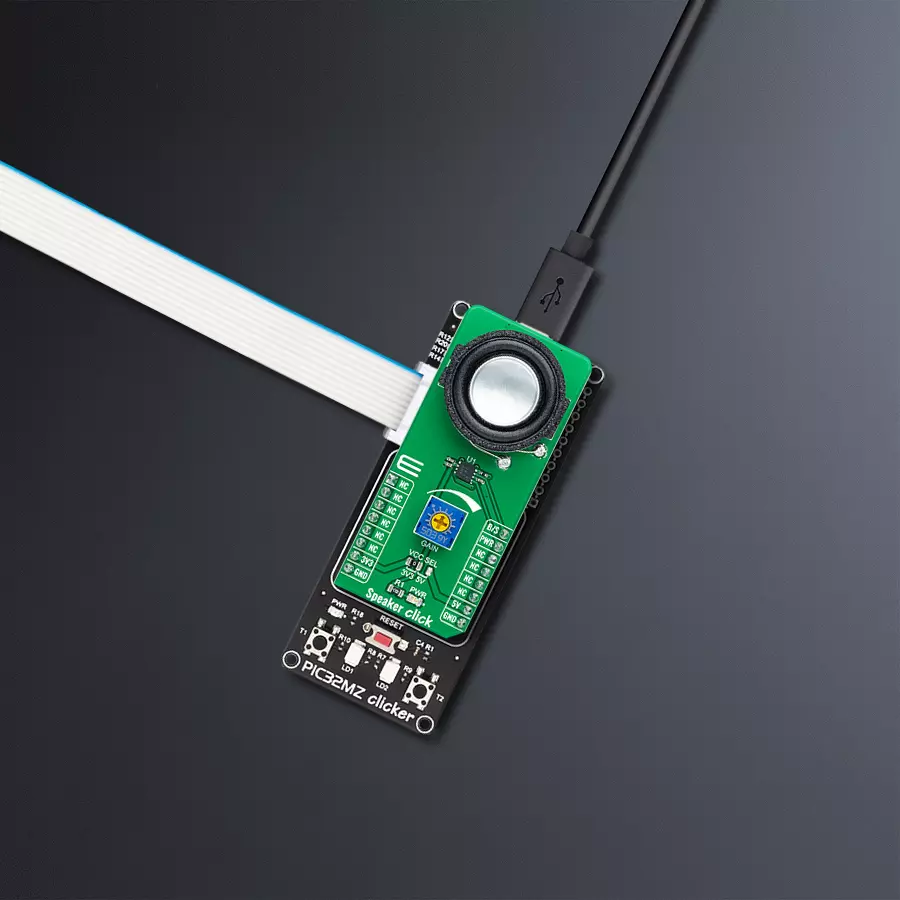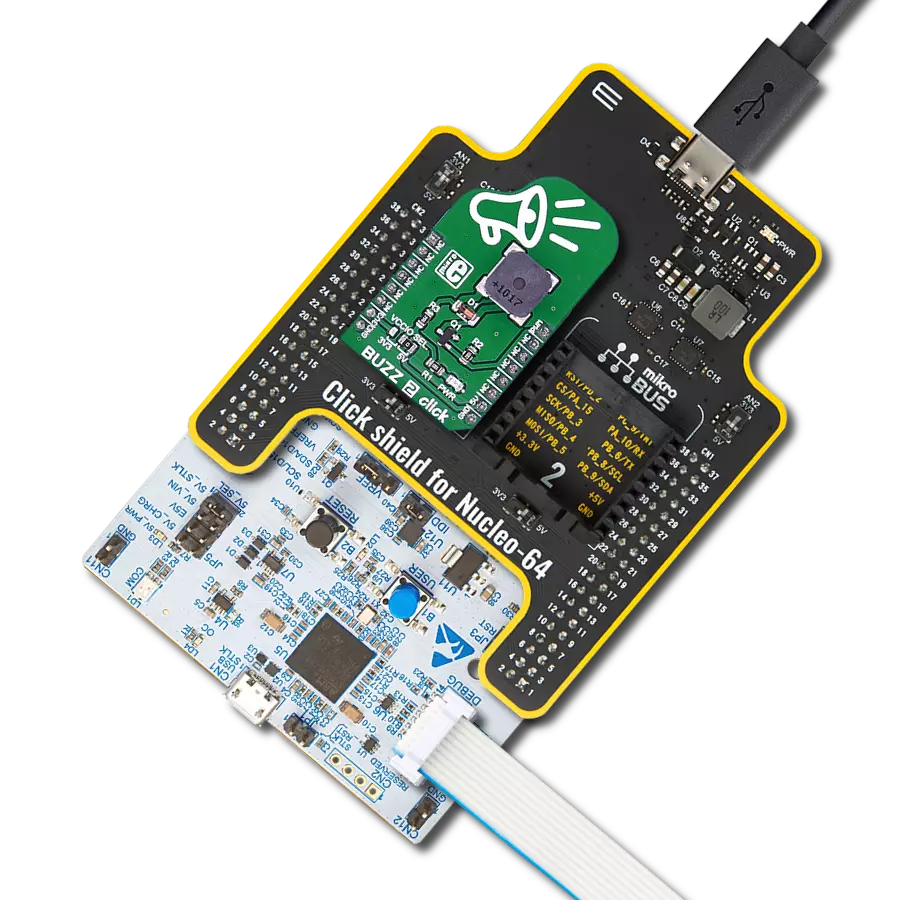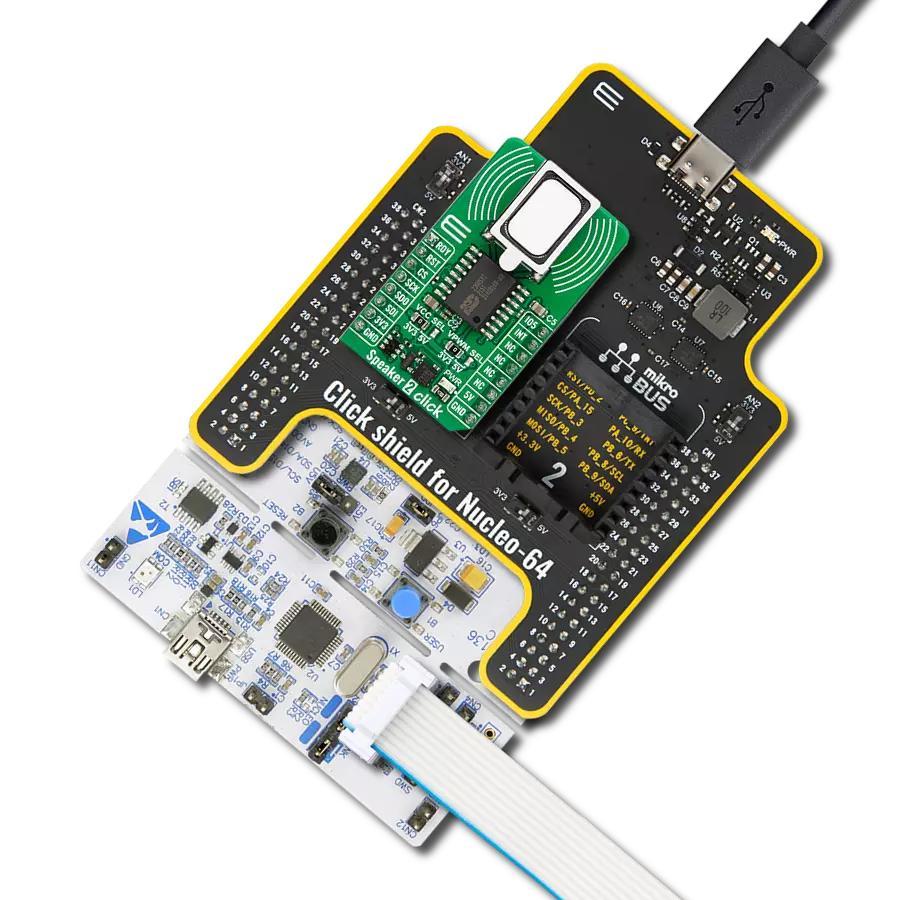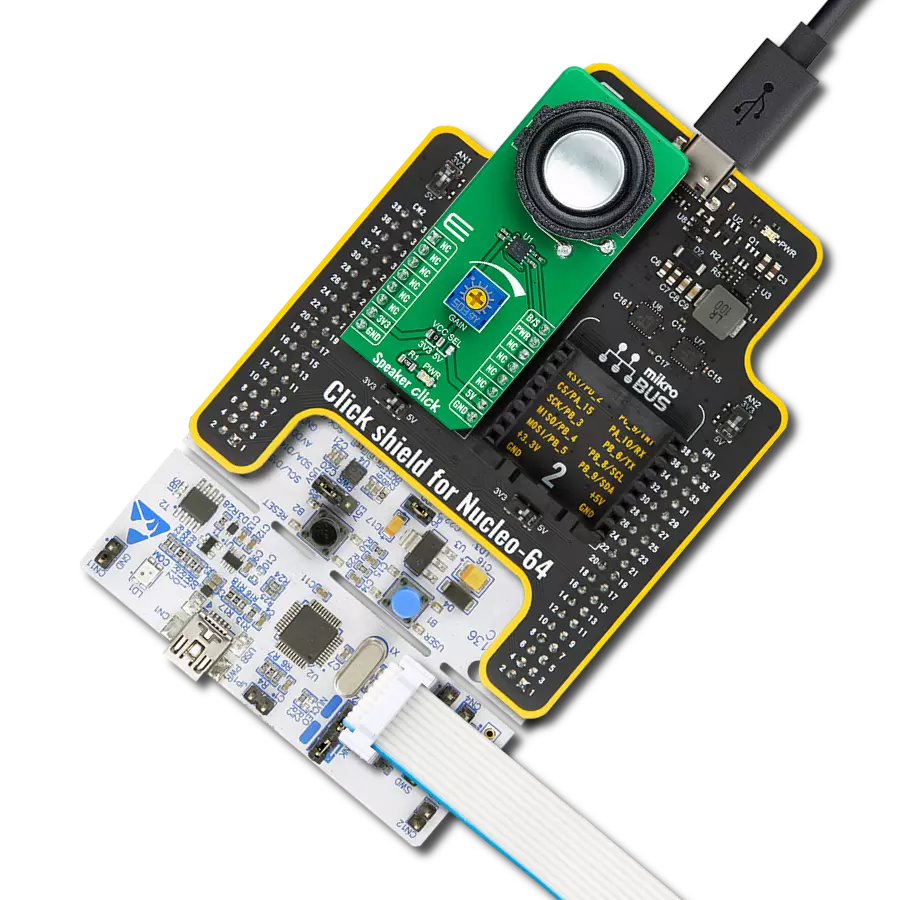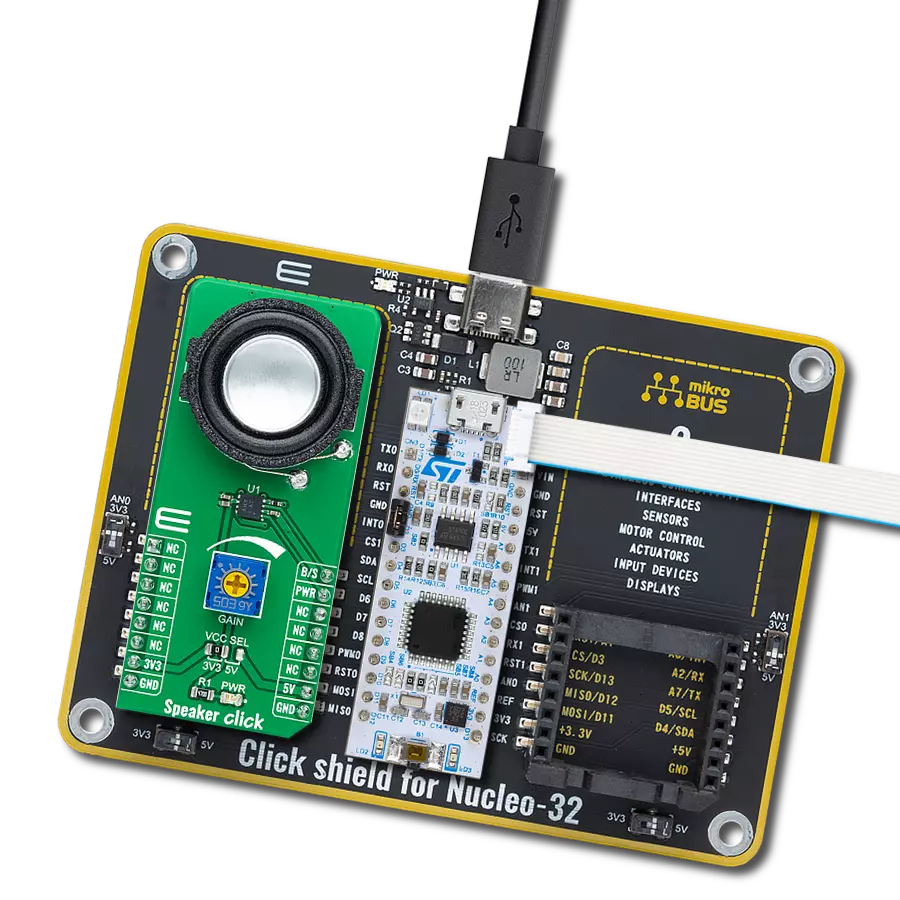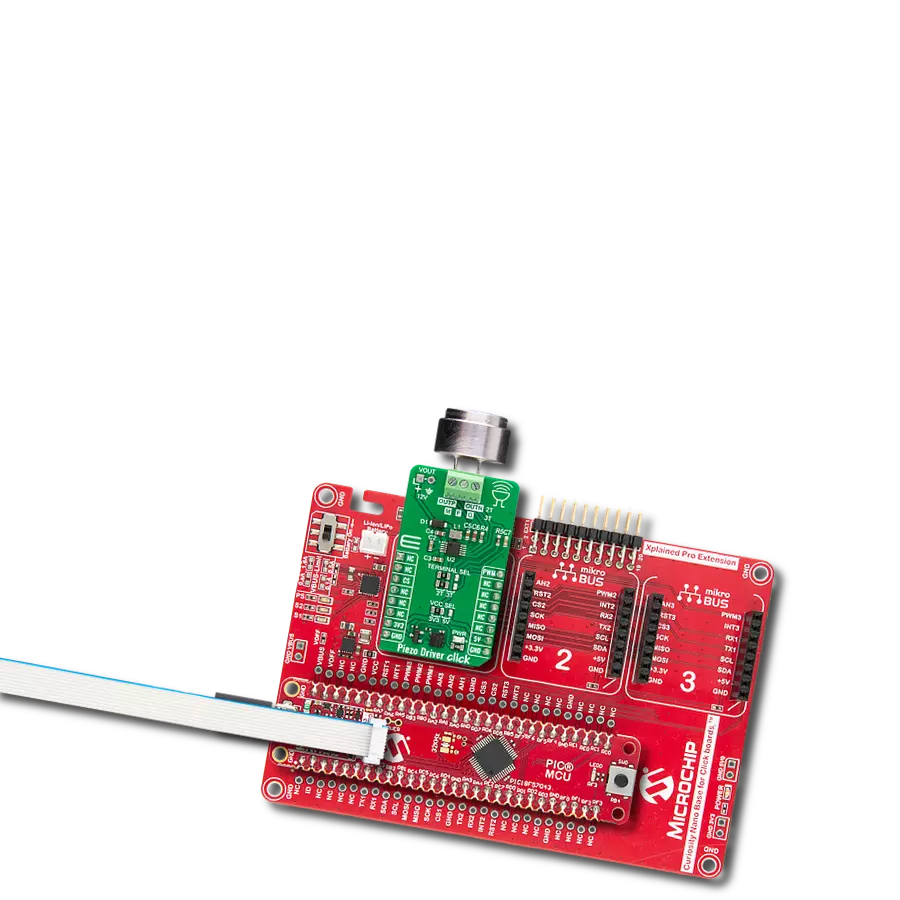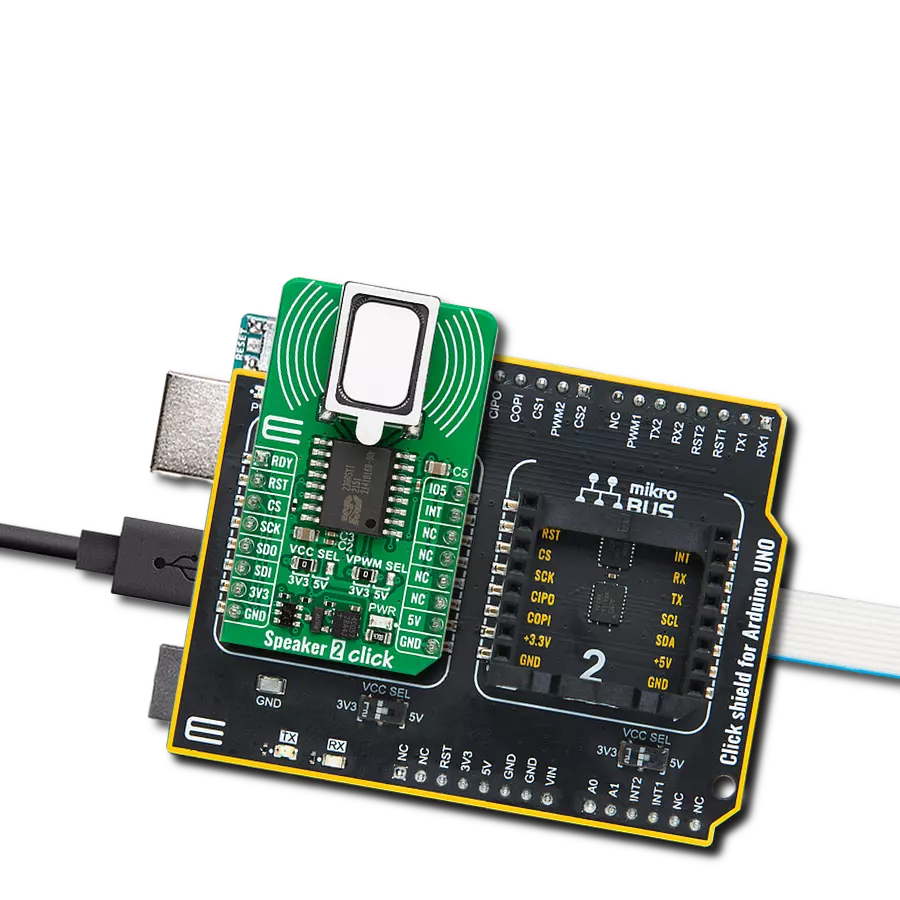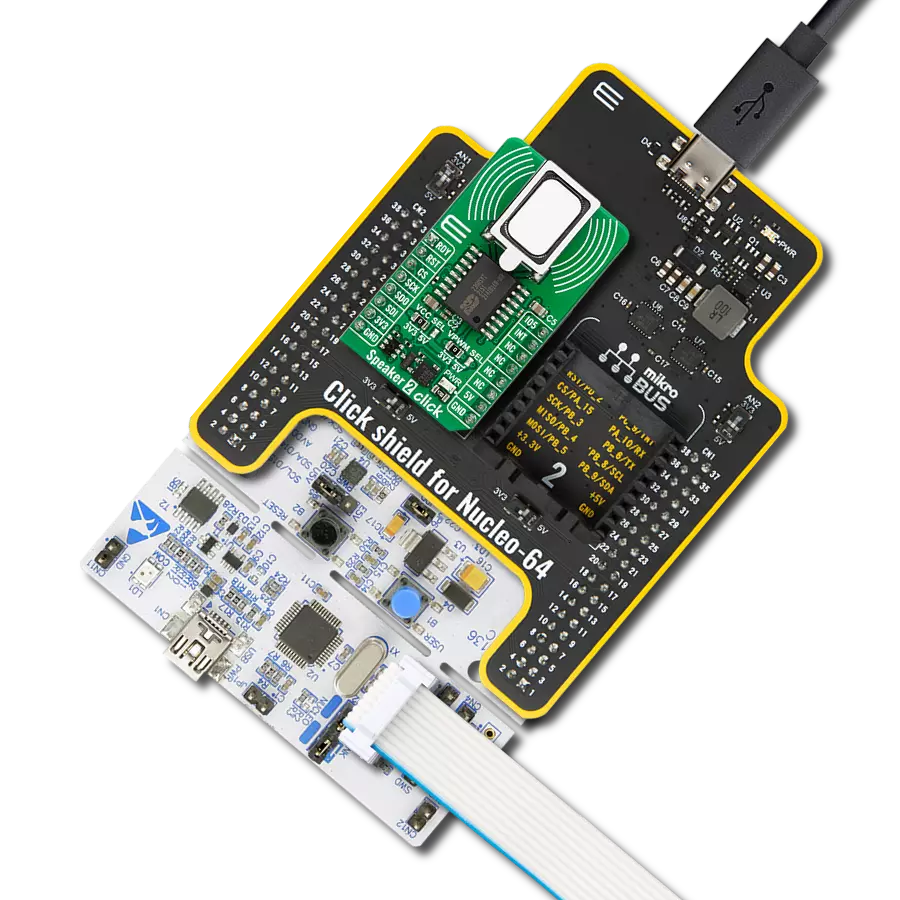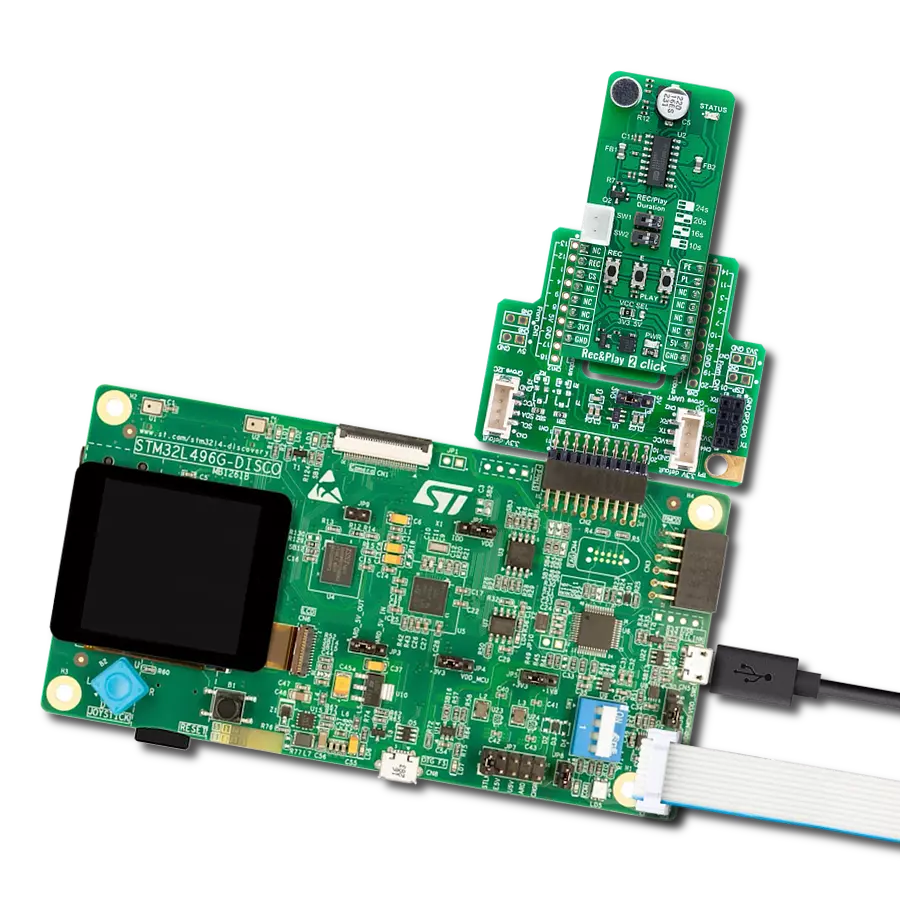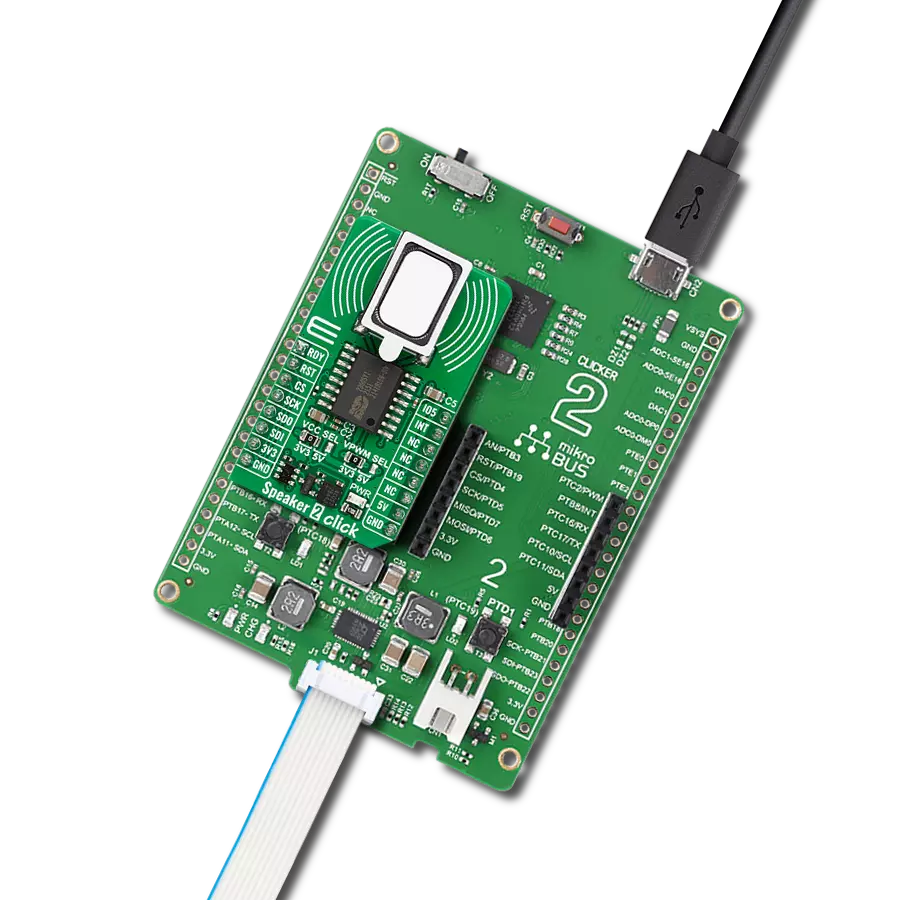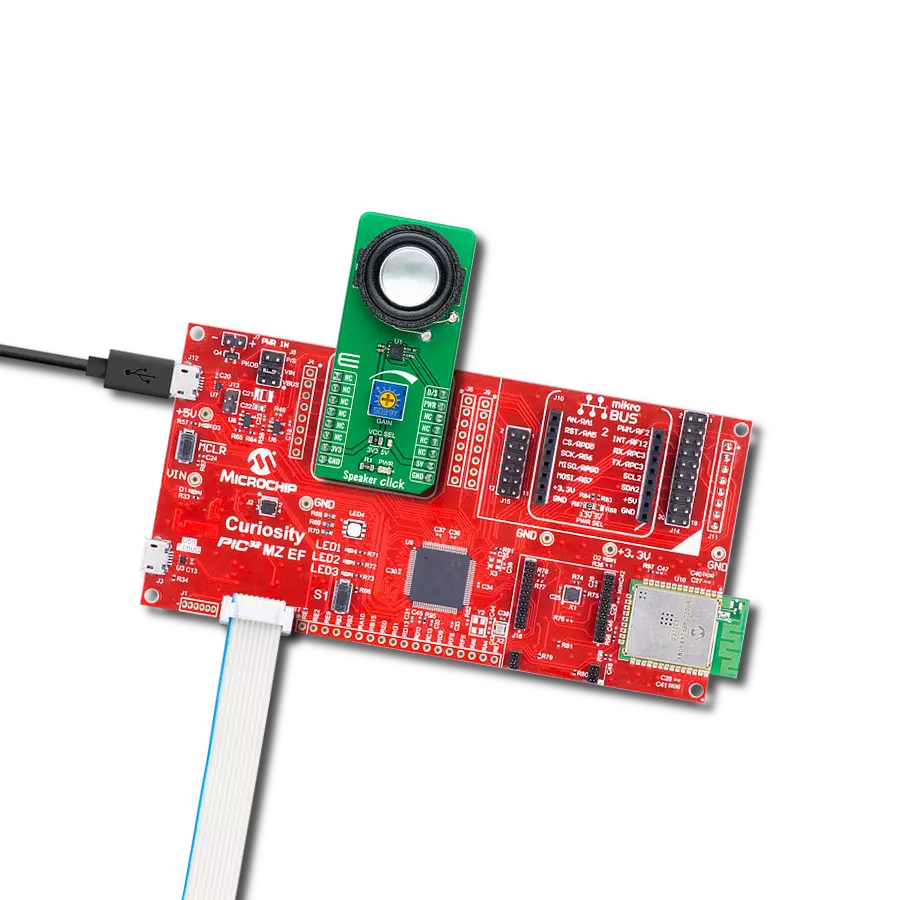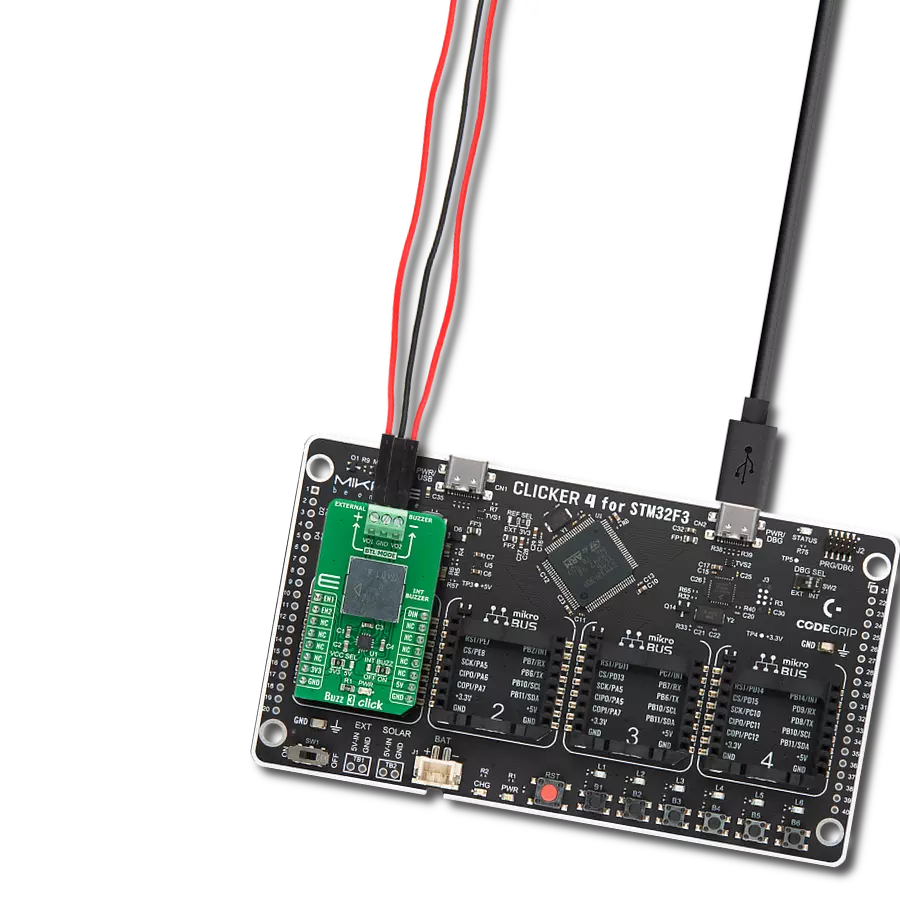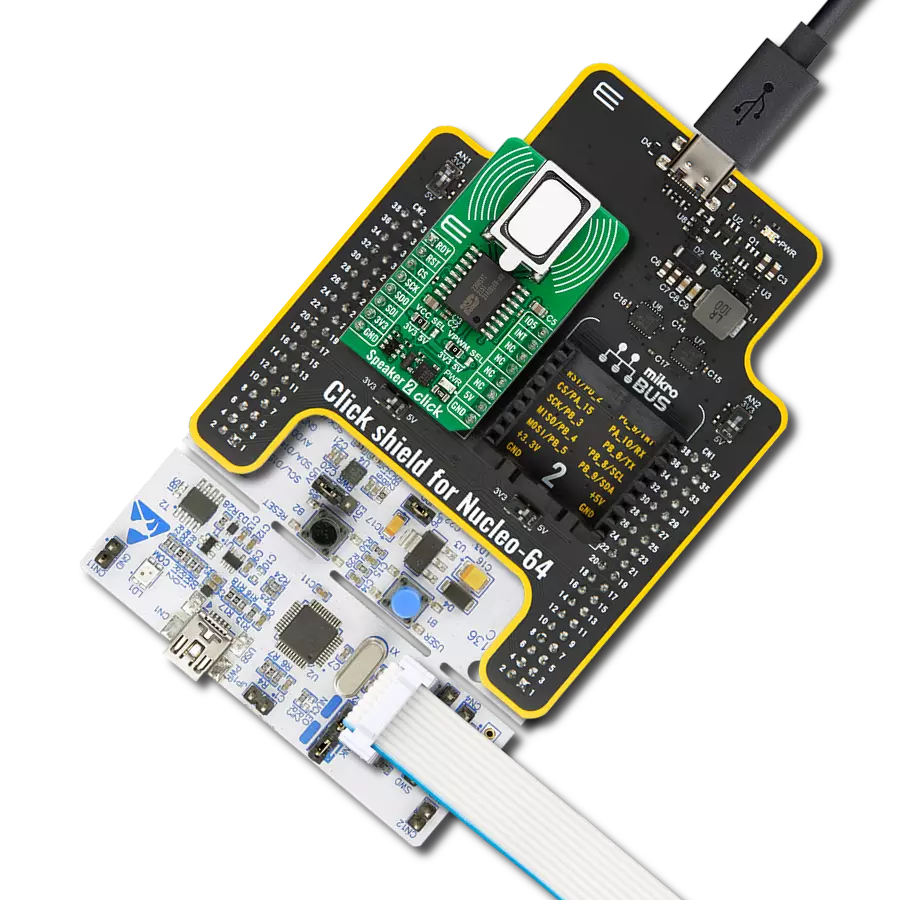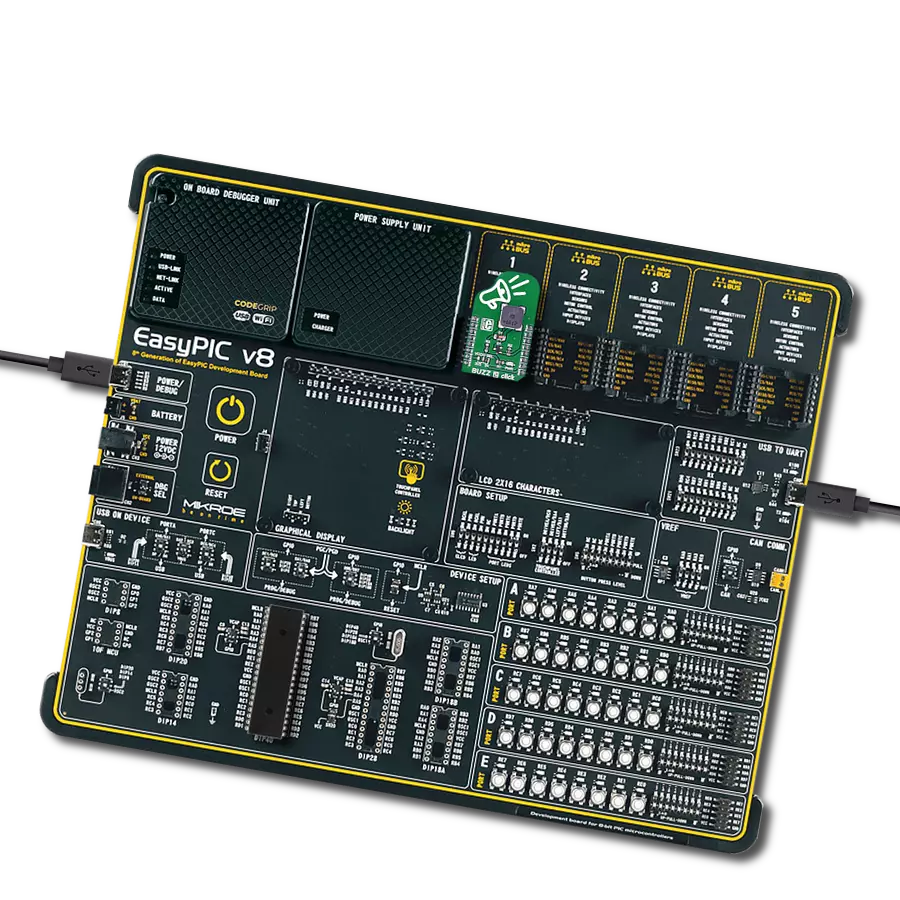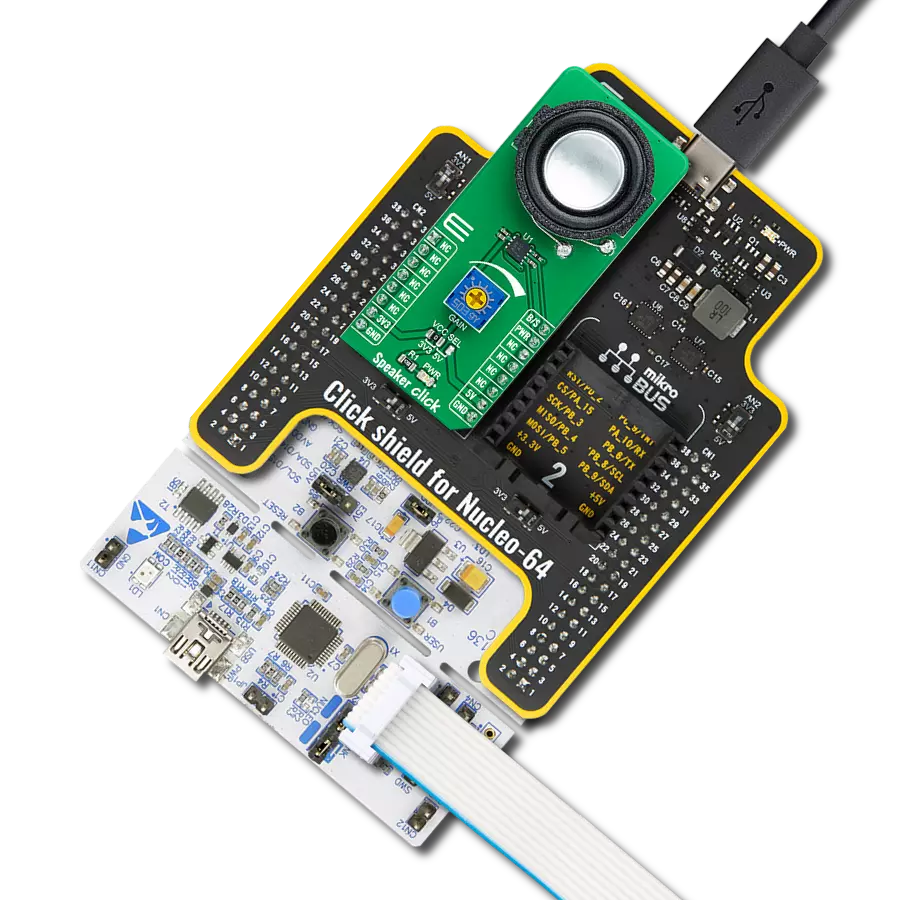Embark on a transformative audio journey as you explore a speaker solution featuring a high-quality audio power amplifier, elevating your audio experience to new heights
A
A
Hardware Overview
How does it work?
Speaker Click is based on the MAX9717, a 1.4W mono bridge-tied load (BTL) architecture audio power amplifier with a high-quality audio reproduction from Analog Devices. It delivers 1.4W continuous power into a 4Ω load from a single +5V supply or 350mW continuous power into an 8Ω load while operating from a single +3.3V supply. This device features Maxim’s industry-leading, comprehensive click-and-pop suppression that reduces audible clicks and pops during the Start-Up and Shutdown sequence. Output signal reproduction is possible through the onboard speaker and the headphone jack located on the bottom side of this Click board™. Speaker Click communicates with MCU using two GPIO pins routed on the PWM and INT pins of the
mikroBUS™ socket labeled B/S and PWR. The MAX9717 features a low-power shutdown mode that reduces quiescent current consumption to 10nA. Entering shutdown mode is possible through the PWR pin, which turns off the bias circuitry and forces the amplifier outputs to GND through an internal 20kΩ resistor. Driving the PWR to a low logic state will cause MAX9717 to enter shutdown mode while the high state will perform a normal operation. As mentioned, this Click board™ has a 20mm 4Ω Premium Micro Transducer onboard speaker for sound reproduction. This speaker features a neodymium-iron-boron magnet, a light aluminum cone, and a high-temperature polycarbonate frame with low resonant frequencies and a full-range
bandwidth. Also, the MAX9717 features a headphone sense input pin, labeled as B/S, that senses headphone connection to the device through a 3.5mm jack connector labeled HEADPHONES. This feature mutes the speaker while driving the headphones as a single-ended load. An adjustable potentiometer labeled GAIN adjusts the gain of the MAXS9717‘s internal amplifier. This Click board™ can operate with either 3.3V or 5V logic voltage levels selected via the VCC SEL jumper. This way, both 3.3V and 5V capable MCUs can use the communication lines properly. Also, this Click board™ comes equipped with a library containing easy-to-use functions and an example code that can be used as a reference for further development.
Features overview
Development board
PIC32MZ Clicker is a compact starter development board that brings the flexibility of add-on Click boards™ to your favorite microcontroller, making it a perfect starter kit for implementing your ideas. It comes with an onboard 32-bit PIC32MZ microcontroller with FPU from Microchip, a USB connector, LED indicators, buttons, a mikroProg connector, and a header for interfacing with external electronics. Thanks to its compact design with clear and easy-recognizable silkscreen markings, it provides a fluid and immersive working experience, allowing access anywhere and under
any circumstances. Each part of the PIC32MZ Clicker development kit contains the components necessary for the most efficient operation of the same board. In addition to the possibility of choosing the PIC32MZ Clicker programming method, using USB HID mikroBootloader, or through an external mikroProg connector for PIC, dsPIC, or PIC32 programmer, the Clicker board also includes a clean and regulated power supply module for the development kit. The USB Micro-B connection can provide up to 500mA of current, which is more than enough to operate all onboard
and additional modules. All communication methods that mikroBUS™ itself supports are on this board, including the well-established mikroBUS™ socket, reset button, and several buttons and LED indicators. PIC32MZ Clicker is an integral part of the Mikroe ecosystem, allowing you to create a new application in minutes. Natively supported by Mikroe software tools, it covers many aspects of prototyping thanks to a considerable number of different Click boards™ (over a thousand boards), the number of which is growing every day.
Microcontroller Overview
MCU Card / MCU
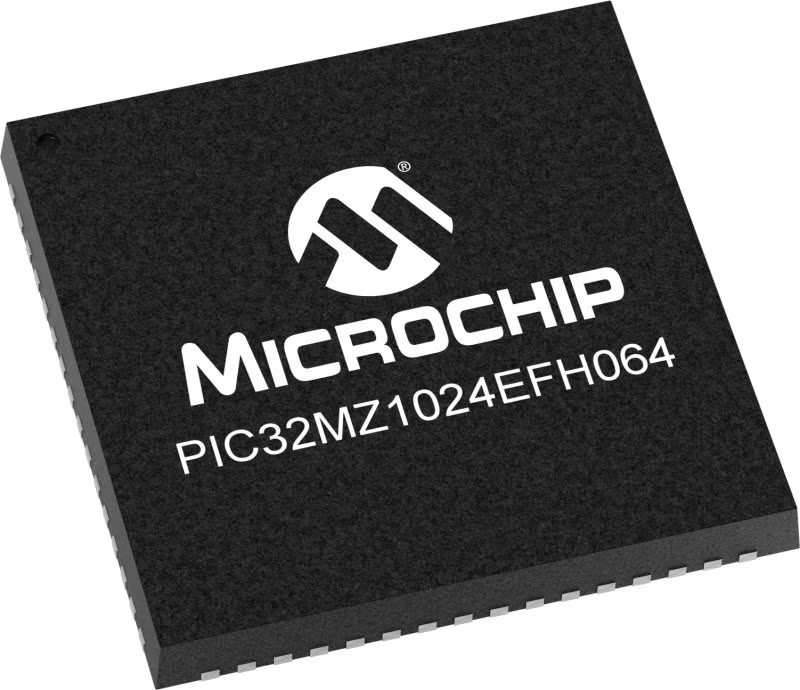
Architecture
PIC32
MCU Memory (KB)
1024
Silicon Vendor
Microchip
Pin count
64
RAM (Bytes)
524288
Used MCU Pins
mikroBUS™ mapper
Take a closer look
Click board™ Schematic

Step by step
Project assembly
Software Support
Library Description
This library contains API for Speaker Click driver.
Key functions:
speaker_shutdown- Speaker shutdown mode functionspeaker_normal_operation- Speaker normal operation mode functionspeaker_enable_slave_amp- Speaker enables the slave amplifier function
Open Source
Code example
The complete application code and a ready-to-use project are available through the NECTO Studio Package Manager for direct installation in the NECTO Studio. The application code can also be found on the MIKROE GitHub account.
/*!
* @file main.c
* @brief Speaker Click Example.
*
* # Description
* This library contains API for the Speaker Click driver.
* This application controls the operating modes of the
* Speaker Click board™.
*
* The demo application is composed of two sections :
*
* ## Application Init
* Initialization of GPIO module and log UART.
* After driver initialization, the application performs the default settings.
*
* ## Application Task
* This is an example that shows the use of a Speaker Click board™.
* The task of the application consists of
* switching two modes of operation: normal and shutdown modes.
* Results are being sent to the Usart Terminal where you can track their changes.
*
* @author Nenad Filipovic
*
*/
#include "board.h"
#include "log.h"
#include "speaker.h"
static speaker_t speaker; /**< Speaker Click driver object. */
static log_t logger; /**< Logger object. */
void application_init ( void ) {
log_cfg_t log_cfg; /**< Logger config object. */
speaker_cfg_t speaker_cfg; /**< Click config object. */
/**
* Logger initialization.
* Default baud rate: 115200
* Default log level: LOG_LEVEL_DEBUG
* @note If USB_UART_RX and USB_UART_TX
* are defined as HAL_PIN_NC, you will
* need to define them manually for log to work.
* See @b LOG_MAP_USB_UART macro definition for detailed explanation.
*/
LOG_MAP_USB_UART( log_cfg );
log_init( &logger, &log_cfg );
log_printf( &logger, "\r\n" );
log_info( &logger, " Application Init " );
// Click initialization.
speaker_cfg_setup( &speaker_cfg );
SPEAKER_MAP_MIKROBUS( speaker_cfg, MIKROBUS_1 );
if ( speaker_init( &speaker, &speaker_cfg ) == DIGITAL_OUT_UNSUPPORTED_PIN ) {
log_error( &logger, " Application Init Error. " );
log_info( &logger, " Please, run program again... " );
for ( ; ; );
}
speaker_default_cfg ( &speaker );
log_info( &logger, " Application Task " );
Delay_ms ( 100 );
}
void application_task ( void ) {
log_printf( &logger, "-------------------------\r\n" );
log_printf( &logger, " Normal Operation Mode \r\n" );
speaker_normal_operation( &speaker );
// 10 seconds delay
Delay_ms ( 1000 );
Delay_ms ( 1000 );
Delay_ms ( 1000 );
Delay_ms ( 1000 );
Delay_ms ( 1000 );
Delay_ms ( 1000 );
Delay_ms ( 1000 );
Delay_ms ( 1000 );
Delay_ms ( 1000 );
Delay_ms ( 1000 );
log_printf( &logger, "-------------------------\r\n" );
log_printf( &logger, " Enter Shutdown Mode \r\n" );
speaker_shutdown( &speaker );
// 10 seconds delay
Delay_ms ( 1000 );
Delay_ms ( 1000 );
Delay_ms ( 1000 );
Delay_ms ( 1000 );
Delay_ms ( 1000 );
Delay_ms ( 1000 );
Delay_ms ( 1000 );
Delay_ms ( 1000 );
Delay_ms ( 1000 );
Delay_ms ( 1000 );
}
int main ( void )
{
/* Do not remove this line or clock might not be set correctly. */
#ifdef PREINIT_SUPPORTED
preinit();
#endif
application_init( );
for ( ; ; )
{
application_task( );
}
return 0;
}
// ------------------------------------------------------------------------ END
